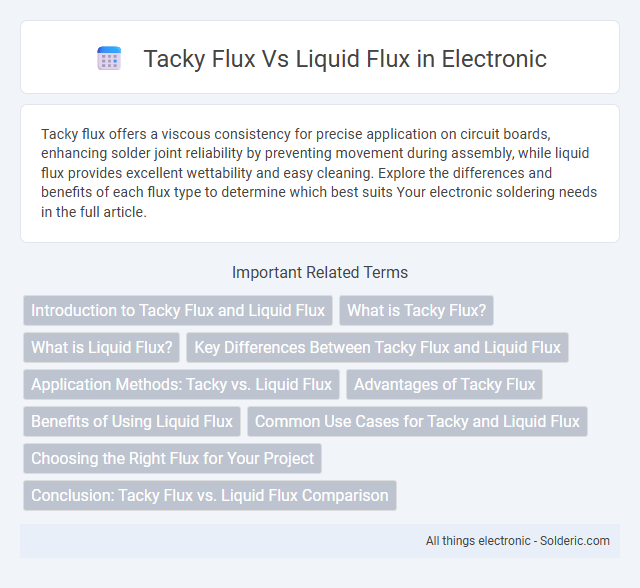Tacky flux offers a viscous consistency for precise application on circuit boards, enhancing solder joint reliability by preventing movement during assembly, while liquid flux provides excellent wettability and easy cleaning. Explore the differences and benefits of each flux type to determine which best suits Your electronic soldering needs in the full article.
Comparison Table
| Feature | Tacky Flux | Liquid Flux |
|---|---|---|
| Consistency | Thick, sticky paste | Thin, free-flowing liquid |
| Application | Precise, controlled application | Easy to spread over large areas |
| Residue | Sticky residue, often needs cleaning | Less residue, some types are no-clean |
| Use Case | Small components, rework, detailed soldering | Mass soldering, wave soldering, PCB assembly |
| Activation Temperature | Typically 180degC - 230degC | Typically 150degC - 220degC |
| Flux Types Available | Rosin-based, water soluble, no-clean | Rosin-based, water soluble, no-clean |
| Cleaning Required | Often required due to sticky residue | Depends on flux type; no-clean often no cleaning needed |
| Storage | Longer shelf life, less evaporation | Shorter shelf life, risk of drying out |
Introduction to Tacky Flux and Liquid Flux
Tacky flux and liquid flux are essential materials in soldering processes, each designed to improve solder joint quality by promoting better wettability and preventing oxidation. Tacky flux is a viscous, gel-like substance that adheres firmly to components, minimizing movement during assembly and providing extended activity during reflow soldering. Liquid flux, in contrast, is a thinner, more fluid formulation that allows easy application for cleaning and soldering, commonly used in wave soldering and hand-soldering operations.
What is Tacky Flux?
Tacky flux is a type of soldering flux designed with a sticky, gel-like consistency that holds components firmly in place during the soldering process, preventing movement and ensuring precise alignment. Unlike liquid flux, tacky flux minimizes spatter and improves solder joint quality by maintaining flux coverage throughout heating. You benefit from enhanced control and cleaner joints, making tacky flux ideal for surface mount technology (SMT) and delicate electronics assembly tasks.
What is Liquid Flux?
Liquid flux is a chemical agent used in soldering to clean and prepare metal surfaces, ensuring better adhesion of solder by removing oxides and contaminants. Unlike tacky flux, which is thicker and sticky to hold components in place, liquid flux offers a thinner consistency for smoother application and is ideal for intricate or delicate electronic assemblies. Your choice between liquid flux and tacky flux depends on the specific soldering task and the need for precision or component stability.
Key Differences Between Tacky Flux and Liquid Flux
Tacky flux is a gel-like adhesive substance that stays in place on the solder joint, providing better control and reduced mess during soldering, while liquid flux is more fluid and spreads easily, making it suitable for cleaning and fluxing larger areas. Tacky flux typically offers stronger residue adherence and longer shelf life compared to liquid flux, which evaporates faster and can require more frequent application. The choice between tacky and liquid flux depends on the precision of the soldering task and the ease of post-solder cleaning required.
Application Methods: Tacky vs. Liquid Flux
Tacky flux is applied using syringes or dispensing equipment, allowing precise placement on specific PCB areas, which minimizes waste and improves control during soldering. Liquid flux is typically brushed or sprayed onto the surface, covering larger areas quickly but with less accuracy, making it suitable for general cleaning and soldering tasks. The choice between tacky and liquid flux depends on the required precision and the complexity of the soldering process.
Advantages of Tacky Flux
Tacky flux offers superior adhesion properties, ensuring it remains in place during soldering and reduces the risk of bridging or shorts on circuit boards. Its viscosity allows for precise application, minimizing waste and preventing excessive spread compared to liquid flux. This controlled placement enhances solder joint quality and improves overall manufacturing reliability in electronic assembly processes.
Benefits of Using Liquid Flux
Liquid flux offers superior wetting properties, ensuring better solder joint quality and reducing defects during PCB assembly. Its availability in various formulations allows precise control over residue types, facilitating easier cleaning and improving electrical performance. The flow characteristics of liquid flux enhance penetration in tight spaces, making it ideal for complex or high-density soldering tasks.
Common Use Cases for Tacky and Liquid Flux
Tacky flux is commonly used in surface mount technology (SMT) applications for its ability to hold components in place during soldering, making it ideal for fine-pitch ICs and rework processes. Liquid flux is preferred for through-hole soldering, wave soldering, and hand soldering due to its easy application and effective cleaning properties that ensure strong solder joints. Both flux types improve wetting and reduce oxidation, but selection depends on the assembly method and component sensitivity.
Choosing the Right Flux for Your Project
Tacky flux offers the advantage of staying in place during soldering, making it ideal for vertical or complex assemblies where precise application is crucial. Liquid flux provides better coverage for large areas and can be easily cleaned after soldering, suitable for projects requiring thorough wetting and minimizing residue. Choosing the right flux depends on your project's specific needs, including component size, joint type, and cleanup preferences.
Conclusion: Tacky Flux vs. Liquid Flux Comparison
Tacky flux offers superior adhesion and reduced mess, making it ideal for vertical or complex soldering tasks, while liquid flux provides easy application and quick cleaning, suited for large surface areas. Your choice depends on the project's precision requirements and cleanup preferences. For detailed, controlled soldering, tacky flux typically outperforms liquid flux in efficiency and reliability.
tacky flux vs liquid flux Infographic

 solderic.com
solderic.com